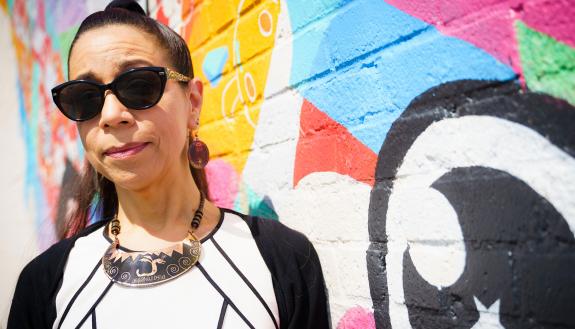The Power of the Cherokee Language at Duke
National conference highlighted a year of instruction and networking for new language program


Arriving at Duke in 2022, Lewis is the inaugural director of the university’s Native American Studies Initiative (NASI). Last year, she helped launch the Cherokee Language Course Series, the first Indigenous American language offered by Duke’s Trinity College of Arts & Sciences.
The effect of Sequoyah’s syllabary was immediate and far-reaching, with Cherokee literacy rates far surpassing English literacy rates throughout the Southeast.
“Sequoyah finished it in 1821. The Cherokee Nation adopted it in 1825, and then three years later, it’s already in the [Cherokee Phoenix] newspaper,” Lewis said.
“Cherokee people quickly became the most literate people in the region, and in Oklahoma,” she added. “They go on to start their own schools, one of which is still in operation today. The written language was adopted very quickly. It was disseminated very quickly.”
The Importance of Mentorship
April was a busy month for students enrolled in the Cherokee 102 Language class. A three-day Cherokee Scholars Research Gathering at Duke kicked off the month, followed by a stage performance in Cherokee of The Wizard of Oz at the Coffeehouse on East Campus, and a Powwow on April 12.
The activities culminated with a demonstration of their Cherokee language skills at a Cherokee Language Summit at Western Carolina University.
The centerpiece of the Cherokee Scholars conference at Duke consisted of pairing junior academics with senior scholars who are members of the Cherokee Nation.
“Mentorship was really important,” she added. “Language was very important.”
Lewis said a repeated theme during the two-day conference was communities supporting one another.
“How are we working together as community when you’re going through tough times?” she asked. “People tend to hunker down (individually) instead of making sure that we are solidifying our connection to the community in a very responsible way,” she added. “And I think part of the conference was to do that and remind us just how important it is to stay strong as a community.”
Historically, Cherokee and other Indigenous languages were “made all-but illegal” by policies and practices resulting from “multiple ongoing governmental efforts over multiple generations,” Lewis said.
One devastating policy was the promotion of federally funded Indian boarding schools during the 19th and 20th centuries, including one at Trinity College when it was in Randolph County. The school enrolled 20 students before it closed in 1887.
“This is where the federal government is paying religious institutes to ‘kill the Indian and save the man,’” Lewis said. “That’s the quote. Their entire purpose with the children is to wipe out any aspect of their ‘Indianness,’ but especially language. Children across the country were heavily abused for using their language.”
The Year of American Indian Pop Culture
One can’t change history, but Duke is working to positively address the past. The university is doing this with the addition of the Cherokee language program and the hiring in recent years of Native American scholars such as Lewis, Ryan Emanuel, a hydrologist with the Nicholas School of the Environment and member of the Lumbee tribe, and three junior scholars as part of the NASI.

Lewis pointed to a cornucopia of Cherokee language learning activities and events on campus for the coming academic year.
“Next year is going to be the big year,” she said. “It’s going to be The Year of American Indian Pop Culture,” to fulfill the NASI goals of visibility, education and research.
“Part of the visibility portion is to have contemporary American Indian Studies creators and educators visible on campus to educate people on who American Indians are today,” said Lewis, who added that the events next year “will represent a broad swath of Indigenous Peoples in the United States.”
Among the featured activities is a mini version of the Indigenous Comic.com festival (IndigiPopX or IPX) in the fall, which will feature visual artists, vendors and academic panelists who will talk about current American Indian culture and writing.
“[IPX] is something I’ve been involved in for years, and it has really exploded recently,” Lewis said. “You bring together writers. You bring together artists. You bring together digital creators. It’s this continuation of all this creativity in one format, and it ranges from humorous super-Indian comics to very serious graphic novels on boarding schools.”
Lewis is also set to curate an American Indian pop culture exhibit in August at the Nasher Museum of Art.
During the spring semester, a Rubenstein Native American artist-in-residence will be on campus. The theatre production “Bear Grease,” an “alt-Indigenous musical” now playing in New York. will be staged, along with a concert featuring the Julia Keefe Indigenous Big Band. There will also be an academic book release, from Duke University Press, on campus for Cornell University professor Jodi A. Byrd’s book about Indigenous video games.
“So really the fall through the spring covers the whole genre of American Indian pop culture,” Lewis said. “And then after that, I take a nap.”
RELATED STORIES

